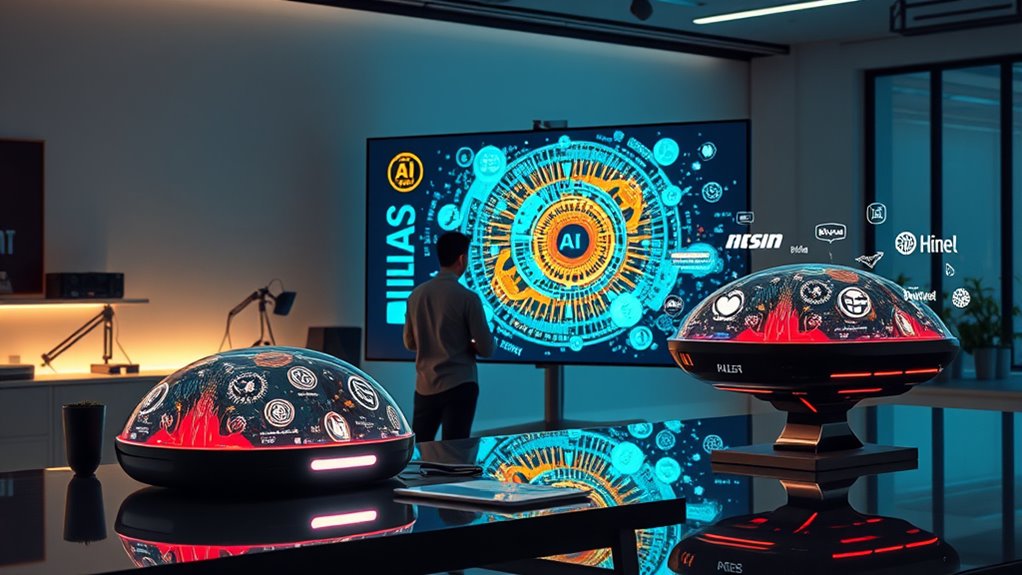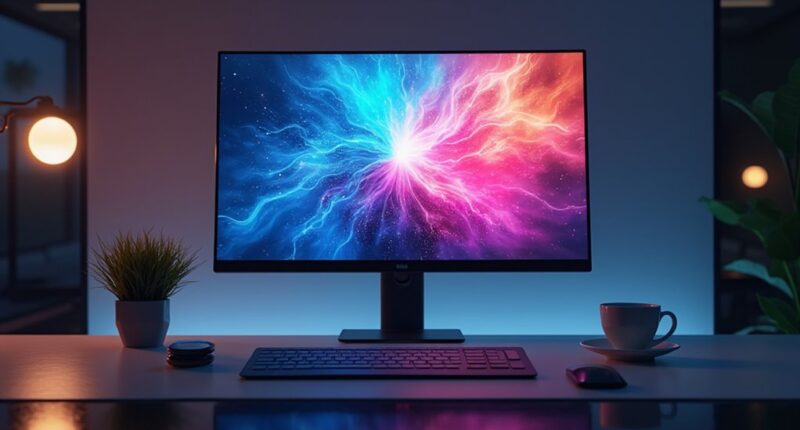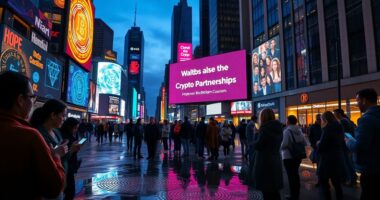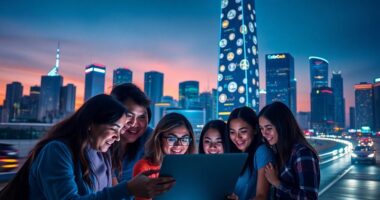Brands are increasingly embracing AI as their new creative partner, transforming how they develop visuals, campaigns, and personalized experiences. AI tools automate repetitive tasks, freeing up your team to focus on storytelling and strategic ideas. Major companies are launching campaigns entirely crafted with generative AI, boosting efficiency and innovation. With AI’s ability to enhance personalization and scale content quickly, it’s clear that integrating AI is essential for future marketing success—discover how this shift can impact you moving forward.
Key Takeaways
- Major brands like Coca-Cola are launching campaigns entirely created with generative AI.
- AI automates repetitive design tasks, freeing creatives to focus on storytelling and brand identity.
- Personalized marketing experiences are enhanced through AI-driven predictive analytics and content customization.
- AI tools enable rapid, scalable content creation, allowing brands to respond quickly to market trends.
- The growing adoption of AI as a strategic partner is transforming brand storytelling and creative processes.

Have you noticed how AI is transforming creativity? Today, brands are increasingly turning to artificial intelligence to revolutionize their marketing and content strategies. With AI-driven tools, creating visual content has become faster and more scalable than ever. Every day, around 34 million AI-generated images flood the internet, drastically reducing the time and resources needed for traditional photoshoots. Since 2022, over 15 billion AI images have been produced—an astonishing volume that would have taken nearly 149 years using conventional methods. Most of these images, approximately 80%, rely on open-source models like Stable Diffusion, which dominate the creative workflow and make high-quality visuals accessible to a broader range of brands and creators. Platforms like Adobe Firefly exemplify this trend, having generated over 7 billion images since early 2023, signaling rapid adoption among brands keen to leverage generative AI. The AI market is projected to surpass $800 billion by 2030, indicating its growing influence across industries. As a consumer, you’re also embracing AI creative tools. Between 60% and 72% of individuals involved in creative tasks now use general AI assistants, while about 25% to 32% utilize specialized AI tools for visual and audio content. These tools, including Canva, Gamma AI, Leonardo AI, and Midjourney, dominate consumer spend, with nearly half of the AI creative budget dedicated to them. The growth in monetization reflects a rising demand for high-quality, customizable media. Users prioritize control and the ability to refine AI-generated outputs, emphasizing that human taste remains the key factor distinguishing successful content from the rest. This shift underscores how AI is not replacing creativity but enhancing it, giving you more power to craft compelling stories efficiently. Cozy textiles can also be incorporated into your creative environment, fostering an inviting atmosphere that enhances productivity.
AI generates over 15 billion images since 2022, transforming visual content creation at unprecedented scale and speed.
Market-wise, AI marketing is booming. The global AI marketing industry is expected to double from $20 billion in 2022 to $40 billion by 2025, driven by increased adoption across sectors like finance, retail, and healthcare. Smaller enterprises are investing 25% more annually, fueling this momentum. North America currently captures about 35% of the market, but Asia-Pacific regions are experiencing even faster growth. As consumer expectations rise and data availability expands, companies feel the pressure to integrate AI into their marketing efforts to stay competitive.
AI isn’t just a tool; it’s becoming a creative partner for brands. Major companies like Coca-Cola have launched campaigns entirely crafted with generative AI, demonstrating its real-world impact. By automating repetitive design tasks, AI frees creative professionals to focus on storytelling and brand identity. Personalization is also enhanced through predictive analytics, allowing tailored marketing experiences that resonate more deeply with audiences. When combined with human insight, AI offers a powerful way to produce engaging, efficient, and personalized campaigns—an essential edge in today’s fast-paced marketplace.
Looking ahead, the economic potential of generative AI is staggering. Revenues from AI software are projected to reach $280 billion by 2032, growing at a CAGR of 42%. North America leads this surge, capturing over 40% of global revenue, thanks to the concentration of advanced technology. As AI continues to evolve, it’s clear that brands embracing this partnership will shape the future of creativity, making AI not just a tool but a crucial collaborator in the art of brand storytelling.
Frequently Asked Questions
How Do Brands Ensure AI Maintains Brand Authenticity?
You guarantee AI maintains brand authenticity by regularly monitoring its outputs and aligning them with your core values. You incorporate human oversight to review and adjust content, keeping the tone genuine and consistent. Using authentic visuals and stories from real people fosters trust. Additionally, you communicate transparently about AI use and data handling, reinforcing your commitment to honesty and emotional connection, which helps sustain a trustworthy brand image.
What Ethical Considerations Arise With Ai-Driven Creativity?
You face a maze of ethical considerations with AI-driven creativity. It’s like walking a tightrope, balancing innovation with responsibility. You must guard against algorithmic bias, ensure transparency, and protect privacy. Fairness and inclusivity become your guiding stars, preventing discrimination and promoting diversity. You also need to prevent misuse, uphold artistic integrity, and stay compliant with regulations. Steering through these ethical waters ensures your AI creations remain trustworthy and socially responsible.
Can AI Replace Human Creative Roles Entirely?
AI can’t fully replace human creative roles because it lacks emotional intelligence, cultural understanding, and intuition. While AI can handle repetitive tasks and generate content, you bring originality, empathy, and nuanced storytelling that AI can’t replicate. Your creativity involves abstract thinking and emotional resonance, making human input essential. Instead of replacement, AI acts as a powerful tool to enhance your work, allowing you to focus on strategic, innovative, and emotionally compelling aspects of creativity.
How Do Consumers Perceive Ai-Created Brand Content?
You perceive AI-created brand content as increasingly recognizable, especially if you’re in the Millennial age group or from the U.S. It can feel impersonal or less trustworthy, and many might hesitate to purchase from brands that heavily use AI. Still, some of you appreciate personalized experiences, but privacy concerns and trust issues remain. Overall, your perception is evolving, balancing curiosity and skepticism about AI’s role in marketing.
What Skills Do Marketers Need to Collaborate Effectively With AI?
You need strong technical skills, like prompt engineering and data literacy, to communicate effectively with AI tools. Developing creativity and strategic thinking helps you blend human insight with AI outputs. Good collaboration skills are essential to coordinate hybrid teams and manage AI-driven campaigns. Stay adaptable by continuously learning new AI applications, and prioritize ethical practices and compliance to build trust. These skills enable you to leverage AI’s full potential while maintaining brand integrity.
Conclusion
As you embrace AI as your creative partner, you’ll find it’s like having a trusted co-artist by your side, enthusiastic to bring your ideas to life. It’s not about replacing your vision but amplifying it, opening doors to endless possibilities. With AI, your creativity flows freely, like a river carving new paths through uncharted terrain. Together, you and AI can craft innovative stories and designs that captivate and inspire, shaping the future of branding.









